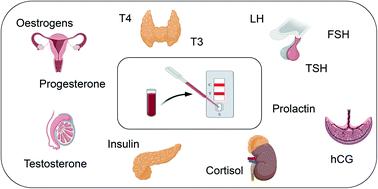Our official English website, www.x-mol.net, welcomes your
feedback! (Note: you will need to create a separate account there.)
Lateral flow assays for hormone detection
Lab on a Chip ( IF 6.1 ) Pub Date : 2022-06-17 , DOI: 10.1039/d1lc00960e Leena Khelifa 1 , Yubing Hu 1 , Nan Jiang 2 , Ali K Yetisen 1
Lab on a Chip ( IF 6.1 ) Pub Date : 2022-06-17 , DOI: 10.1039/d1lc00960e Leena Khelifa 1 , Yubing Hu 1 , Nan Jiang 2 , Ali K Yetisen 1
Affiliation

|
Endocrine diseases are the fifth most common cause of death and have a considerable impact on society given that they induce long-term morbidity in patients. For many decades, the measurement of hormones has been of great interest since this can be used to diagnose a plethora of pathological conditions. As a result, the endocrine testing market has experienced exponential growth. Several techniques have been utilised for the detection of hormones; however, they are expensive, laborious and require specialist training. Conversely, lateral flow assays (LFAs) are cheap (<£1) and rapid (<5 min) devices. LFAs typically rely on biochemical interactions between antibodies and antigens to produce coloured signals proportional to analyte concentrations, which can be visually inspected. Given their simplicity, LFAs are now considered the most attractive point-of-care device in medicine. However, the measurement of hormones in biofluids using LFAs faces many challenges including (i) the necessity for sensitive detection methods, (ii) the need for multiplexed devices for the confirmation of a diagnosis, and (iii) difficulties in sample preparation and pre-concentration. As such, most hormone LFAs remain in the research phase, and the few that have been commercialised require further optimisation before they can be employed for routine use. This review summarises the basic principles underlying lateral flow technology and provides an overview of recent advances, challenges, and potential solutions for the detection of hormone biomarkers via LFAs. Finally, hormone LFA kits available on the market are presented, with a look towards future developments and trends in the field.
中文翻译:

用于激素检测的侧向流动测定
内分泌疾病是第五大最常见的死亡原因,并且对社会产生相当大的影响,因为它们会导致患者长期发病。几十年来,激素的测量一直引起人们的极大兴趣,因为它可以用来诊断过多的病理状况。因此,内分泌检测市场经历了指数级增长。几种技术已被用于检测激素;然而,它们昂贵、费力并且需要专门培训。相反,侧向流动分析 (LFA) 是便宜 (<1) 和快速 (<5 分钟) 的设备。LFA 通常依靠抗体和抗原之间的生化相互作用来产生与分析物浓度成比例的有色信号,可以目视检查。鉴于它们的简单性,LFA 现在被认为是医学领域最具吸引力的即时医疗设备。然而,使用 LFA 测量生物流体中的激素面临许多挑战,包括 (i) 灵敏检测方法的必要性,(ii) 需要用于确认诊断的多路复用设备,以及 (iii) 样品制备和预检测的困难。专注。因此,大多数激素 LFA 仍处于研究阶段,少数已商业化的 LFA 需要进一步优化才能用于常规使用。本综述总结了侧流技术的基本原理,并概述了激素生物标志物检测的最新进展、挑战和潜在解决方案 使用 LFA 测量生物流体中的激素面临许多挑战,包括 (i) 灵敏检测方法的必要性,(ii) 需要用于确认诊断的多路复用设备,以及 (iii) 样品制备和预浓缩的困难。因此,大多数激素 LFA 仍处于研究阶段,少数已商业化的 LFA 需要进一步优化才能用于常规使用。本综述总结了侧流技术的基本原理,并概述了激素生物标志物检测的最新进展、挑战和潜在解决方案 使用 LFA 测量生物流体中的激素面临许多挑战,包括 (i) 灵敏检测方法的必要性,(ii) 需要用于确认诊断的多路复用设备,以及 (iii) 样品制备和预浓缩的困难。因此,大多数激素 LFA 仍处于研究阶段,少数已商业化的 LFA 需要进一步优化才能用于常规使用。本综述总结了侧流技术的基本原理,并概述了激素生物标志物检测的最新进展、挑战和潜在解决方案 因此,大多数激素 LFA 仍处于研究阶段,少数已商业化的 LFA 需要进一步优化才能用于常规使用。本综述总结了侧流技术的基本原理,并概述了激素生物标志物检测的最新进展、挑战和潜在解决方案 因此,大多数激素 LFA 仍处于研究阶段,少数已商业化的 LFA 需要进一步优化才能用于常规使用。本综述总结了侧流技术的基本原理,并概述了激素生物标志物检测的最新进展、挑战和潜在解决方案通过LFA。最后,介绍了市场上可用的激素 LFA 试剂盒,展望了该领域的未来发展和趋势。
更新日期:2022-06-17
中文翻译:

用于激素检测的侧向流动测定
内分泌疾病是第五大最常见的死亡原因,并且对社会产生相当大的影响,因为它们会导致患者长期发病。几十年来,激素的测量一直引起人们的极大兴趣,因为它可以用来诊断过多的病理状况。因此,内分泌检测市场经历了指数级增长。几种技术已被用于检测激素;然而,它们昂贵、费力并且需要专门培训。相反,侧向流动分析 (LFA) 是便宜 (<1) 和快速 (<5 分钟) 的设备。LFA 通常依靠抗体和抗原之间的生化相互作用来产生与分析物浓度成比例的有色信号,可以目视检查。鉴于它们的简单性,LFA 现在被认为是医学领域最具吸引力的即时医疗设备。然而,使用 LFA 测量生物流体中的激素面临许多挑战,包括 (i) 灵敏检测方法的必要性,(ii) 需要用于确认诊断的多路复用设备,以及 (iii) 样品制备和预检测的困难。专注。因此,大多数激素 LFA 仍处于研究阶段,少数已商业化的 LFA 需要进一步优化才能用于常规使用。本综述总结了侧流技术的基本原理,并概述了激素生物标志物检测的最新进展、挑战和潜在解决方案 使用 LFA 测量生物流体中的激素面临许多挑战,包括 (i) 灵敏检测方法的必要性,(ii) 需要用于确认诊断的多路复用设备,以及 (iii) 样品制备和预浓缩的困难。因此,大多数激素 LFA 仍处于研究阶段,少数已商业化的 LFA 需要进一步优化才能用于常规使用。本综述总结了侧流技术的基本原理,并概述了激素生物标志物检测的最新进展、挑战和潜在解决方案 使用 LFA 测量生物流体中的激素面临许多挑战,包括 (i) 灵敏检测方法的必要性,(ii) 需要用于确认诊断的多路复用设备,以及 (iii) 样品制备和预浓缩的困难。因此,大多数激素 LFA 仍处于研究阶段,少数已商业化的 LFA 需要进一步优化才能用于常规使用。本综述总结了侧流技术的基本原理,并概述了激素生物标志物检测的最新进展、挑战和潜在解决方案 因此,大多数激素 LFA 仍处于研究阶段,少数已商业化的 LFA 需要进一步优化才能用于常规使用。本综述总结了侧流技术的基本原理,并概述了激素生物标志物检测的最新进展、挑战和潜在解决方案 因此,大多数激素 LFA 仍处于研究阶段,少数已商业化的 LFA 需要进一步优化才能用于常规使用。本综述总结了侧流技术的基本原理,并概述了激素生物标志物检测的最新进展、挑战和潜在解决方案通过LFA。最后,介绍了市场上可用的激素 LFA 试剂盒,展望了该领域的未来发展和趋势。










































 京公网安备 11010802027423号
京公网安备 11010802027423号